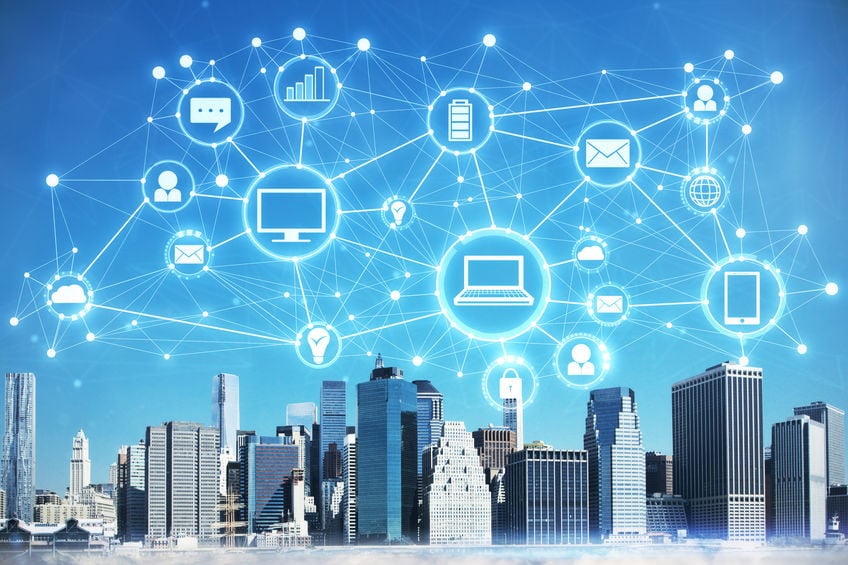 The potential applications of Real Wireless Power -- over air, no charging mats or fancy algorithms required, while in motion -- don’t end with smartphones and personal devices. Intelligent buildings, like retail, will be one of the first markets to embrace and benefit from Real Wireless Power like Cota®.
The potential applications of Real Wireless Power -- over air, no charging mats or fancy algorithms required, while in motion -- don’t end with smartphones and personal devices. Intelligent buildings, like retail, will be one of the first markets to embrace and benefit from Real Wireless Power like Cota®.
More Sustainable with Wireless Power
Considering energy efficiency and environmental design is one aspect of creating a fully intelligent building project, and it’s a big, important one for many. The US Green Building Council notes that “LEED began as a way for new construction (NC) projects to embrace energy efficiency and environmental best practices”[1] and since 2000, the number of registered LEED projects has continued to grow.
Real Wireless Power has the ability to decrease LEED building operational costs by increasing energy efficiency of small devices.
Smarter Buildings with Wireless Power
In additional to sustainability, intelligent building service providers, manufacturers, contractors, and brands are also often striving to create and/or integrate features that make a building “smart.” Think facilities management, data collection, and systems automations that make workers more efficient and the environment safer and more convenient.
These optimizations all require power, which may sound counterproductive to going green, but organizations are finding ways around that, clearly, because more and more intelligent buildings projects are launching all the time. MarketAndMarkets, a B2B research company, states that “the smart building market is expected to grow from an estimated $7.42 billion USD in 2017 to $31.74 billion USD by 2022.”[2]
How do these companies find the extra power and still remain energy efficient? You guessed it: Real Wireless Power. Before we get into all the benefits, let’s first address the issue everyone is concerned about with regard to implementing IoT large-scale: security.
Securely Interconnected Via Wireless Power
Interconnectivity is fundamental to a well-functioning IoT system, and when there’s interconnectivity and communication among devices and people, there’s the potential for security breaches.
Real Wireless Power offers a two-way communication path along with the delivery of power, a path that should be securely managed through cloud software. So even if you have hundreds or thousands of devices communicating throughout a building, all access to this data and functionality should be absolutely controlled by you.
Why Adopt Wireless Power Now?
“Revenue related to installations of sensor-equipped lighting, climate control equipment, thermostats and other automation systems could quadruple [from 2016-2026] to about $732 billion,”[3] reports Navigant Research.
The rate of growth in the smart buildings industry is not sustainable without Real Wireless Power. Wireless power is the common denominator that makes that growth continue. It enables faster installations, user convenience, maintenance facilitation, safer environments, and a smaller environmental footprint, to name a few.
Wireless power receivers will soon be integrated to all small devices and products and wireless power transmitters will be built right into the building construction as a differentiator, a value-add, and potentially a monthly operational cost for companies in the intelligent building industry.
Who Benefits from Wireless Power
The ecosystem on smart building infrastructure organizations is huge: Siemens, Panasonic, Honeywell, IBM, and Cisco[4] are not the only smart technology players. Leading brands like Carrier, Otis and Chubb will benefit from wireless power technology, as will expanding companies like Johnson Controls, which in 2016 merged with Tyco in order to become “uniquely positioned to drive new innovations in technology and business models to support the smart buildings, campuses, and cities of the future.”[5]
Other companies like Tesla, UTC Building & Industrial Systems, Schneider Electric, and ABB are also planning and developing advanced infrastructures systems for intelligent buildings.
This list is by no means comprehensive, but it gives you an idea of the scale of effort and commitment behind future-thinking initiatives that will benefit from wireless power.
Energy Efficiency and Real Wireless Power
Smart grids, smart meter systems, solar power, predictive analytics, energy storage systems … the list of types of energy efficiency opportunities is greater than ever. Wireless power, like Cota, will soon be the de facto energy-efficient solution for a commercial or industrial building’s small device and IoT power needs. Why? Cota Real Wireless Power makes it possible to:
- Eliminate the need for buying and managing disposable batteries.
- Power thousands of inaccessible or hard-to-reach sensors.
- Deliver power to every inch of a room or building by linking transmitters.
- Prioritize which devices get power (or default to lowest battery levels), view the basic power usage of the device, and set up and manage users.
- Put an end to wasted energy; Cota goes into sleep mode when not needed. In contrast, every device and charger that’s plugged in continues to receive some level of power, even when not in use.
Receive more information on how wireless power will impact your intelligent building business: contact Ossia to explore the possibilities. Also read:
- Wireless Buildings: How Wireless Power Will Transform the Way We Build, Work, and Innovate
- The Global Standard for Wireless Power
- Wireless Power: Licensing versus Off-the-Shelf Technology
[1] https://www.usgbc.org/articles/leed-numbers-16-years-steady-growth
[2] https://www.marketsandmarkets.com/PressReleases/smart-building.asp
[3] https://www.navigantresearch.com/newsroom/global-revenue-for-iot-devices-in-the-residential-and-commercial-sectors-is-expected-to-total-732-billion-from-2016-to-2026
[4] ttps://builtworlds.com/insights/50-hottest-technologies-products-systems-smart-buildings/
[5] http://www.johnsoncontrols.com/media-center/news/press-releases/2016/09/06/johnson-controls-and-tyco-complete-merger






